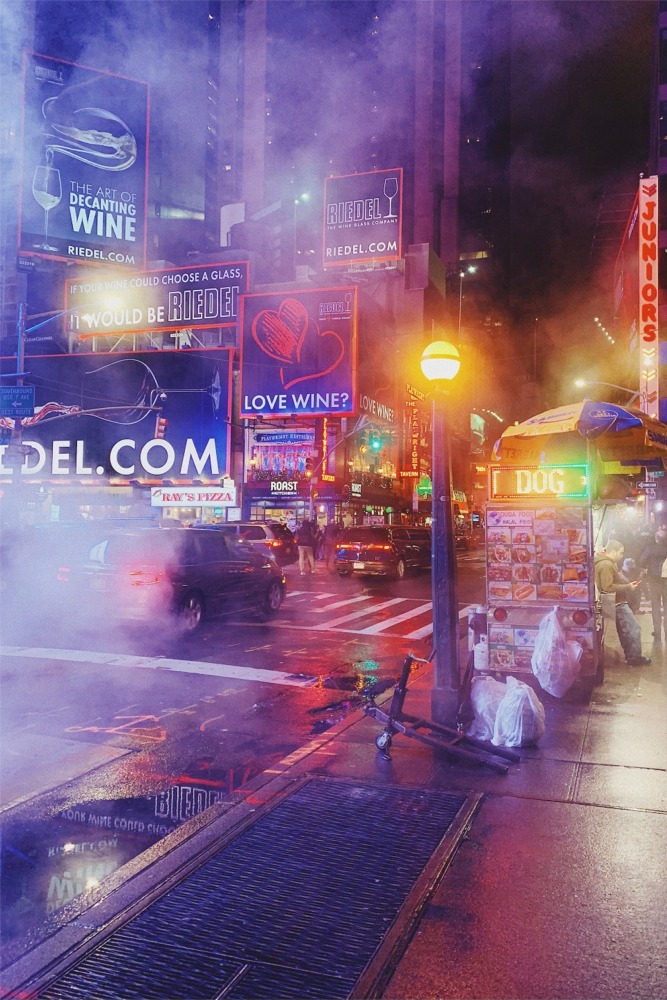150 West 50th Street
Midtown West / Hell's Kitchen
Home > New York State Photographs > New York > 150 West 50th Street, Midtown West

The scene was illuminated by a blanket of lavender, its color mixing with the golden hue from the street lamps and neon signs of midtown west. The hustle and bustle of the city was alive in this little corner of Hell's Kitchen, and at the center of it all was 150 West 50th Street; a stretch of road that was illuminated by the orange glow of car headlights and the constant pulse of a thousand lives.
But what made this scene even more special was the figure sitting beneath the streetlight, a solitary hotdog vendor armed with a cell phone sheltering under an umbrella. He had been there for hours, selling his wares to the passersby and providing an almost ethereal presence in the urban landscape. He was part of the fabric of this city, and his presence here was both a reminder and an invitation to the incredible possibilities of this place.
Watching the vendor, it seemed that this was no ordinary night in Hell's Kitchen. This was a night for dreaming, for aspirations and ambitions, for hope and for possibility. It was a night for reminding ourselves that no matter what obstacles we face in life, no matter how difficult the journey may be, we always have the power to make a difference. This man, this humble street vendor, was showing us that with a little determination and dedication, anything is possible.
Hell's Kitchen
Hell's Kitchen is a neighborhood located on the west side of Midtown Manhattan in New York City. Historically, the area was known for its rough reputation and was associated with crime and a gritty atmosphere. However, in recent years, it has undergone significant gentrification and transformation, becoming a diverse and vibrant neighborhood with a mix of residential, commercial, and cultural attractions.
History
The origins of the name "Hell's Kitchen" are uncertain, but there are a few theories. Some believe it was derived from a notorious tenement building named "The Hell's Kitchen" that was known for its lawlessness and violence. Another theory suggests the name came from a comment made by Davy Crockett, relating to residents of the Five Points, a 19th-century neighborhood in Lower Manhattan.
Evolution and Gentrification
In the late 19th and early 20th centuries, Hell's Kitchen was a working-class and predominantly Irish-American neighborhood. Over the years, it was known for its tenements, poverty, and high crime rates. However, in the latter half of the 20th century, the neighborhood started to change as gentrification began to take place. With its proximity to the Theater District, Midtown, and Hudson River Park, Hell's Kitchen became an attractive location for young professionals, artists, and actors. The real estate development and renovation of older buildings led to an influx of new residents and a rise in property values.
Residential and Community Life
Today, Hell's Kitchen is a mix of residential buildings, restaurants, bars, shops, and entertainment venues. The neighborhood is known for its diverse community, with residents from various ethnic backgrounds. The area has a lively nightlife scene and a wide range of dining options, making it a popular destination for locals and visitors alike.
Cultural and Entertainment Attractions
Hell's Kitchen offers a variety of cultural attractions and entertainment options. The Intrepid Sea, Air & Space Museum, housed on the USS Intrepid aircraft carrier, is a popular museum in the area. Additionally, the neighborhood is home to several theaters and performance spaces, contributing to its artistic and creative vibe.
Location and Accessibility
Hell's Kitchen benefits from its central location in Manhattan, making it easily accessible by public transportation. It is served by several subway lines and bus routes, providing convenient connections to other parts of the city.
Overall, Hell's Kitchen has experienced significant changes throughout its history, evolving from a rough and gritty neighborhood to a vibrant and dynamic area with a mix of cultures, cuisines, and entertainment options. It remains an exciting and desirable place to live and explore in New York City.


